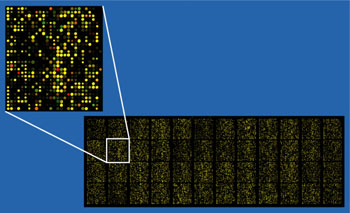Two-Gene Panel Differentiates between Pediatric Bacterial and Viral Infections
By LabMedica International staff writers
Posted on 06 Sep 2016
A two-gene panel was shown to differentiate between viral and bacterial infections in children with fevers with 95-100% accuracy.Posted on 06 Sep 2016
Since clinical features do not reliably distinguish bacterial from viral infection, many children worldwide receive unnecessary antibiotic treatment, while bacterial infection is missed in others. To solve this problem, investigators at Imperial College London (United Kingdom) sought to identify a blood RNA expression signature that could distinguish bacterial from viral infection in febrile children.

Image: An example of an approximately 40,000 probe spotted RNA microarray with enlarged inset to show detail (Photo courtesy of Wikimedia Commons).
Toward this end, the investigators performed RNA microarray analysis screening on white blood cell samples taken from children with an average age of 19 months, who had arrived with fever at hospitals across the United Kingdom, Spain, the Netherlands and the USA. The children were placed into groups that were classified after microbiological investigation as having definite bacterial infection, definite viral infection, or indeterminate infection. RNA expression signatures distinguishing definite bacterial from viral infection were identified in a discovery group of 240 subjects, and diagnostic performance was assessed in the validation group of 130 subjects.
The discovery group of 240 children included 52 with definite bacterial infection, of whom 36 required intensive care, and 92 with definite viral infection, of whom 32 required intensive care. Ninety-six children had indeterminate infection. Analysis of RNA expression data identified a 38-transcript signature distinguishing bacterial from viral infection. A smaller (two-transcript) signature (FAM89A and IFI44L) was identified by removing highly correlated transcripts.
When the two-transcript signature was implemented as a disease risk score in the validation group (130 children, with 23 definite bacterial, 28 definite viral, and 79 indeterminate infections), all 23 patients with microbiologically confirmed definite bacterial infection were classified as bacterial and 27 of 28 patients with definite viral infection were classified as viral. Of the children in the indeterminate groups, 46.3% were classified as having bacterial infection, although 94.9% received antibiotic treatment.
Senior author Dr. Michael Levin, professor of medicine at Imperial College London, said, "Fever is one of the most common reasons children are brought to medical care. However every year many children are sent away from emergency departments or doctors' surgeries because the medical team thinks they have a viral infection, when in fact they are suffering from life-threatening bacterial infections - which are often only diagnosed too late. Conversely, many other children are admitted to hospital and receive antibiotics because the medical team is unable to immediately exclude the possibility of a bacterial infection - but in fact they are suffering from a virus. Although this research is at an early stage, the results show bacterial infection can be distinguished from other causes of fever, such as a viral infection, using the pattern of genes that are switched on or off in response to the infection. The challenge is now to transform our findings into a diagnostic test that can be used in hospital emergency departments or GP surgeries, to identify those children who need antibiotics."
Related Links:
Imperial College London














